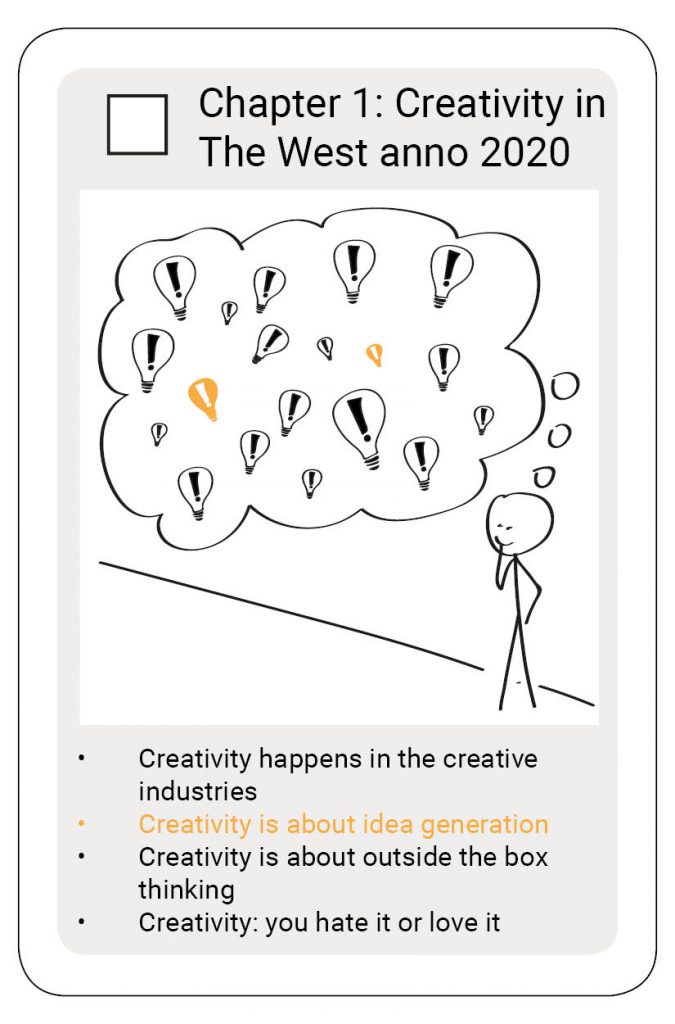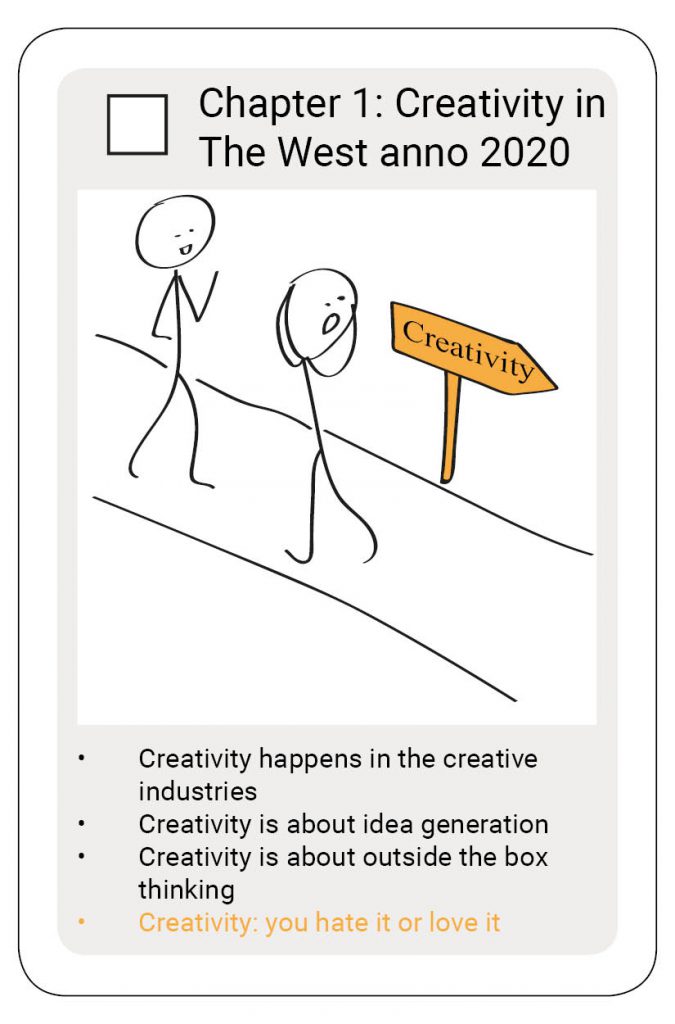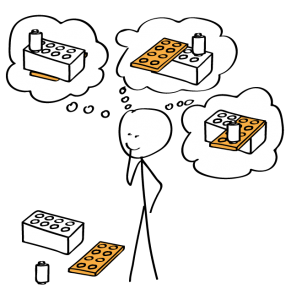CQ3: ‘Creative industries’ should go
Last Summer I was at a creativity conference with the title: Dutch Creativity Festival, organized by the ‘ADCN: Club for Creativity’. I did not check what ADCN was an abbreviation for. It sounded good, Club for Creativity: I’m in! I was expecting talks and workshop on creativity. The why’s, the how’s and the what’s of creativity in organizations. I could not have been more wrong.
ADCN stands for Art Directors Club Netherlands. Oops. There were a lot of film academy students, people from advertising companies, and app-creators. And with 37 I was one of the eldest people there. I felt very untrendy. The thing that stroke me most was the return of the term ‘creatives industries’. I felt they were claiming creativity. I was among peers, being a designer and all, and I felt like an outsider. That wasn’t only due to my age. It was a weird feeling.
The idea that creativity is happening especially in creative industries contradicts with the idea I described in the previous article, that creativity can be found in every activity and in every discipline of work. So what makes this entire industry claim to be more creative than other industries? They don’t actually, it was just the course of history. And we can change that course, that is why I’ll make case for ditching the term creative industries.
Buying being or human being?
The history of creative industries is not my core expertise. I studied several articles to figure out the story for this article. Reading about the history of creative industries gave me the feeling of being a ‘bying being’ instead of a ‘human being’. You will find that the term creative industries are invented by governments who recognized the potential economic value in creating beauty for the mass. It was all about capitalism, consumption and commercialization. [Big Sigh].
I’ll start the history with the introduction of the predecessor of creative industries, namely cultural industries. Then I will go to the relation between cultural industries and the mass media, to the introduction to the term creative industries. Finally, I will discuss the meaninglessness of the term ‘creative industries’ and give a few alternatives.
Cultural industries
The term ‘cultural industries’ was first written down by Theodor W. Adorno and Max Horkheimer, both scholarly refugees from the Nazis in the 1940s (Moore, 2014). For them, the term had a negative connotation. The authors changed the term ‘mass culture’ into ‘culture industry’, to emphasize the capitalistic view on art. They felt that profit had become more important than the expression of the emotion of the artist.
Ironically, despite the fact that Ardono and Horkheimer were against the link between culture* and industry, their term actually strengthened the link. Art was made to sell to the mass to make profits. That was made possible by industrial production, using the newest technologies.
(*The term culture can be confusing. In the previous article, I argued that the meaning of the word changed in the Industrial Revolution from a way to describe art in a way to describe the beliefs and customs of a group of people (see the previous article). It this case, culture means a way to describe art. I guess both definitions go around today.)
Ardono’s and Horkheimer’s view on cultural industries foretold the commercialization of art. Today, we let the market decide the quality of the art. Art is not being collected for the long term because you simply cannot estimate its future value. It is left in the hands of capitalism (Weiner, 2005) I am too Romantic to believe this is true. But that is not the point here. Back to cultural industries. We need to discuss mass media.
Cultural industries and mass media
The 1950s was the big rise of mass media. Television made it possible to bring culture (= art in this context) to the mass. This type of art was for entertainment purposes and got the name popculture. Where popculture is more about confirming and conservating the present and high-art is more about exploring the new. The first is for ‘the people’ and the second is generally assumed to be for the ‘elite few’. Why did television, radio and film become part of the cultural industries?
Somehow Cunningham (2002) and Moore (2014) don’t explicitly answer this question. Moore (2014) writes the following:
‘Cultural industries are defined as those, which have industrial production and organization to produce and disseminate symbols. This definition naturally points to media in general and digital media in particular’ (Moore, 2014: p741). Maybe it is me, but I don’t see the A to B logic in this.
And according to Cunningham (2002), we should read Caves (2000) to answer this question. I haven’t read Caves so I can only make an estimated guess on how this relation was born. My estimated guess is that with the rise of the consumption society, entertainment became a form of art: popculture. And entertainment was brought to the people through television, radio and film. So the medium itself became part of cultural industries.
Mass media is of course more than television, radio and film. Advertising companies were also part of cultural industries. And I can see the art in a good add. I’m pretty sure that the relation between art and commerce is again the answer why we place advertising companies under the flag of cultural industries.
I find it frustrating that I don’t fully understand it because that makes it difficult for me to pass on knowledge to you. But I’m going to leave the topic here. Read Caves (2000) if you want to know more about the relationship between mass media and cultural industries and why this relationship exists. Moving on. The next question is on the change from cultural industries to creative industries. What happened there?
How did cultural industries become creative industries?
The change in the term is rooted in societal and technological advancements and the further development of commercialization and capitalism. And in fact, it was not the industry itself or scholars that introduced the term. No, the term comes from politics.
It was Australia that first mentioned the term ‘creative industries’ publicly in the new cultural policy ‘Creative nation’ in 1994 (Moore, 2014). The UK adopted the word in 1997, also coming from the national government (Moore, 2014). In the ‘Creative Industries Task Force (CIFT) Mapping Document’ from the UK (1998), creative industries were defined as: ‘Activities which have their origin in individual creativity, skill and talent and which have the potential for wealth and job creation through generation and exploitation of intellectual property’ (Cunningham, 2002: p54). If you look at CIPT’s definition of creative industries, it includes more than the definition I found of cultural industries.
Cunningham (2002) refers to two authors, again Richard Caves who wrote: ‘Creative Industries: Contracts Between Arts and Commerce’ (2000) and John Howkins who wrote: ‘How People Make Money from Ideas’ (2001). The first discusses creative industries as a spectrum between media and art.
The second discusses creativity as a sum of four sectors: ‘the copyright, patent, trademark and design industries’ (Cunningham, 2002: p56).
The first focus more on art, the second involves technology and is of the same level as the definition in the CITF Mapping Document.
When I look at the Dutch organizations (www.creatieve-industrie.nl) that represents the creative industries, they include Business Services Providers like product designers, architects, fashion designers, digital designers, Media & Entertainment, like publishers, game developers, cultural heritage, DJ’s.
From analyzing these theories, I conclude that the word ‘cultural’ (in the art sense) didn’t cover the entire industry anymore. The word became a too narrow description for the industry with the rise of the Internet and due to technological advancements. The definition by Caves (2000) that creative industries are a spectrum between media and art feels outdated. So for the rest of the article, I’m going with Howkin’s sectors, the CIPT definition of the creative industries and the Dutch idea that creative industries drive innovation.
Is creativity than only for the creative industries?
As I mentioned in the introduction we nowadays assume that creativity can be found in every type of activity (see the previous article and I go with this assumption). And that doesn’t line up with calling one industry creative and therewith the other industries not-creative. How can we deal with this now?
The main problem in all commercial industries is: ‘How to deliver product/services/offer that people value and thus want to buy, that is also difficult for other companies to copy in order to maintain a competitive advantage?’ In doing so companies need new ideas that are useful in the context they work in, and therewith have value. Hey, that reminds me of the most frequently used definition in creativity research by Amabile (1996, p35):
‘A product or response will be judges as creative to the extent that (a) it is bot a novel and appropriate, useful, correct or valuable response to the task at hand, and (b) the task is heuristic rather than algorithmic’.
It might not be surprising that Amabile (who is a very friendly and open lady by the way) is a distinguished professor at Harvard Business School. Even though her definition is widely accepted among creativity researchers, I see some problems with it. More on that in chapter three. My point is that the most popular definition of creativity does not only fit creative industries, but it also fits every commercial business.
Historically we can explain why business and creativity were not considered intertwined terms (Madley, 2011). Nowadays it is evident that creativity is part of doing business. It might be at the core of doing business. I referred to the research by the World Economic Forum in which they interviewed Chief Human Resource Officers of large multinationals from nine industries in fifteen different economies, providing them with answers from 371 different companies (WEF, 2016: p3), and creativity comes third as a most important skill.
What about non-commercial industries?
I have not covered creativity in non-commercial industries. What if you are working in the health industry or in education. There is a different type of problem at hand: ‘How can we best take care of our patients or provide the most suitable education.’ If we look at Amabile’s definition, ‘novelty’ might seem less important in non-commercial industries than the other elements of her definition. This is simply because the competition factor is not in play (I know in the neo-capitalistic world this is arguable, but in essence, there should not be). So what about novelty?
For example, the teacher finds herself in a situation where a student will not listen and she manages the situation well. The response ticks the boxes useful and for the task at hand. However, the situation is new by itself so the novelty-element is inevitably part of the response or product. But is this enough novelty to say the teacher was being creative? This is a difficult point and asks for more argumentation. Please decide for yourself by now. I will get back to this topic in chapter three.
What I can say about Amabile’s definition of creativity, is that I am not a fan of it. It feels as if we push creativity in the corner of the business alone, and I don’t want creativity to be doomed only for commercial use.
Creativity happens in every industry
I believe that creativity does not only happen in the creative industries. It at least happens in any commercial industry and also in non-commercial industries. Looking at the topic from a historical perspective I do understand the capitalistic view on art and that art (or culture) became an industry. I sort of understand that media companies became part of this industry, but the change to creative industry is was only for economic purposes anyway. And that doesn’t help to understand creativity.
Alternatives
You can’t only complain, you need to come with an alternative if you think something sucks. Here is a small list of ideas;
- Consumer software industry
- Digital Game industry
- Art industry
- (Social) media industry
Some of these industries already exist. Is there any company I didn’t cover from the creative industries with these four alternatives?
Merging of industries
Even if you disagree with me and accept that there are a certain type of companies that make up the creative industries. Read Cunningham’s (2002) argumentation why to rethink the term creative industries. He argues that creative industries move to service industries and manufacturing industries, and so the meaning becomes so inclusive, research on the topic becomes difficult. Maybe Cunningham should check my shortlist.
Also, it is a trend that ‘creatives’ (excuser le mot) work more and more outside the creative industries, the lines between companies that are part of creative industries and those that are not dissappear. I don’t know the latter scientifically only from what I see happening in my own bubble. Only look at the popularity of Design Thinking (chapter 5). My intuition tells me I’m right…
Conclusion: Creative industries should go
‘Creative industries’, just like the word creativity itself, is a lazy word (see introduction quartet). Historically we can explain why we have this term but there is no reason to keep it. It would be the same as calling an industry the ‘cognitive industry’ or ‘planning industry’. The term creative industries suggest a distinction between other industries, that doesn’t exist.
Creativity doesn’t happen only in the creative industries, even though historically we can understand why we think it does. Again, I refer to the previous article and also in the chapter on the historical beliefs of creativity this link is clarified. There is nothing that makes the creative industries more creative than other industries. If you disagree, please let know.
Check out the topics of the next three weeks below. Next week, the second card from this quartet about creativity as an idea generation activity. That is way more up my alley that this topic.
I wish you a pleasant continuation of your day.
Willemijn



The Creativity Quartet 2020 combines my knowledge on and experience with creativity. Just like any other person I have experience with creativity as long as I live, but more deliberate when I started studying Industrial Design Engineering (IDE@TUDelft) in 2001. I have over fifteen experience in facilitating and training creativity. My interest in creativity theory started in 2015. And I’m currently looking into doing promotional research on creating an overview of creativity theories.
I provide training in creativity & problem-solving to professionals, and I love to talk about creativity & problem solving on stage. To practice creativity, I also design serious/business games by request (Your Nine Dots) and I teach at IDE@TUDelft.
I do my best to source and summarize correctly. However, if you read anything incorrect or of the hook, please let me know! Ending with my favourite quote on creativity by Maya Angelou: “You can never use up creativity. The more you use, the more you have.”
References
- Cunningham, S. (2002). From Cultural to Creative Industries: Theory, Industry and Policy Implications. Media International Australia incorporating Culture and Policy. No. 102, pp. 54-65.
- Mayfield, M. (2011). Business/Management. In Encyclopedia of Creativity: Second Edition, eds. Runco, M. A. and Pritzker S.R., London, UK: Academic Press, 2011, Vol 1. pp. 170-175.
- Moore, I. (2014). Cultural and Creative concept – a historical perspective. Procedia – Social and Behavioural Sciences, 110, pp. 738-746.
- Weiner, R. P. (2005). Creativity & beyond: Cultures, values and change.Albany, NY: State University of New York Press.
Tags:
SUGGESTIONS FOR FURTHER READING

CQ13: Could Einstein paint like Picasso?
Could Einstein paint like Picasso? No. And Picasso was no brainiac like Einstein was. We give both men credit for their great creative contributions,

CQ15: What is the difference between creativity and innovation?
I recently became the new President of the European Association of Creativity & Innovation (EACI)*. From that perspective, it would be nice to cla

CQ20: Geneplore: theory ready for practical use
Geneplore is a merge of two words: generate & explore (Finke, et al., 1992). The Geneplore model is described in a book called Creative Cognition,

Title photo
Inspiration for inspiration
Would you like to receive the Creativity Quartet 2020 as inspiration? Think about how you can inspire us. For example, we have a coffee, you send us a book or article, link us to a person, point us to a website, etc. Leave your name and e-mail address and we’ll contact you for further information. We will not use your e-mail address to send you offers and won’t give away your information to other parties.




